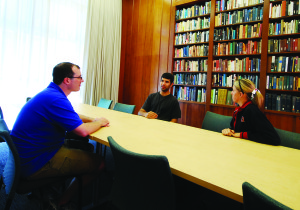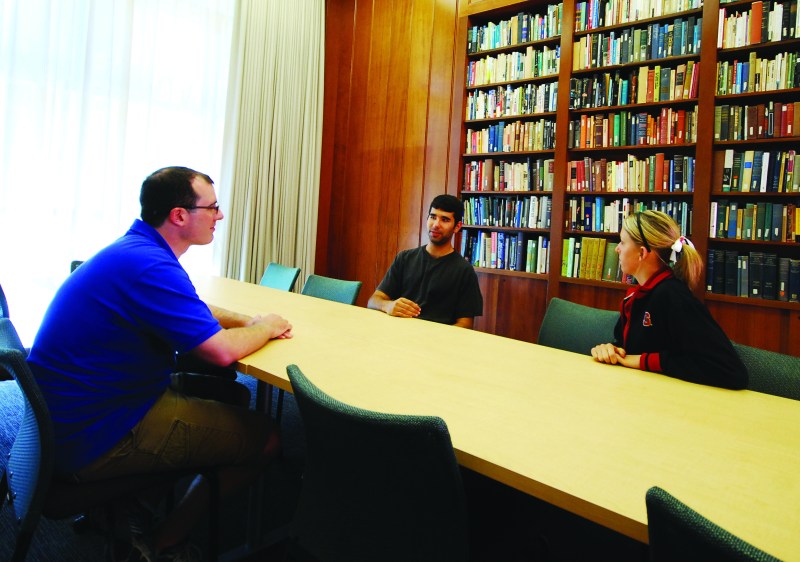As the class of 2017 arrived at Stanford on Tuesday, 88 of its members moved into Burbank house in Stern Hall to take part in two new integrated learning environments for the upcoming academic year: ITALIC and SIMILE.
The newly established programs center on a yearlong, residence-based learning experience similar to the existing Structured Liberal Education program (SLE) but with an emphasis on different subjects. Immersion in the Arts: Living in Culture (ITALIC) will focus on the arts, while Science in the Making: Integrated Learning Environment (SIMILE) will have curriculum based on the history of science.
Both programs, which were very popular among incoming freshmen, are intended to give students an opportunity to look at traditional subjects in fresh ways.
“We’re pretty excited about them and excited about the fact that they offer freshmen an alternative that might be right for them in terms of fulfilling requirements,” said Vice Provost for Undergraduate Education Harry Elam.

Arts opportunities embraced through ITALIC
Although Stanford is best known for its computer science and engineering departments, the Farm is also home to incredible arts facilities.
The Cantor Arts Center has one of the largest collections of Rodin sculptures in the world. The Bing Concert Hall, home to the Stanford Beethoven Project, boasts state-of-the-art technical capabilities and hosts renowned artists such as Yo-Yo Ma.
“Not every university has a world class concert hall and a museum that rivals major institutions of the city,” said ITALIC Assistant Director Aaron Shkuda. “It’s natural to integrate arts courses with these offerings.”
ITALIC will help increase student interaction with these facilities and potentially improve Stanford’s arts program overall — US News & World Report ranked Stanford as number one for computer science graduate program and number two for undergraduate engineering, but number 36 for graduate studies in fine arts.
Throughout their first year, the 44 freshmen in the program will study, create and analyze various forms of art, including visual, performing, film and design. The program is divided into three topics that will be explored throughout the year.
“The university wants to say, ‘Hey, this is really important, the arts matter,’” said ITALIC Faculty Director Janice Ross M.A. ’75 Ph.D. ’98. “We’re at a moment where the arts and humanities have to be rethought, and this is one of the sharpest, boldest rethinkings I’ve seen.”
In the first quarter, lecturers will pose the question: Why art?
According to Ross, students will attempt to understand how art affects a human’s mind by examining cognition, neuroscience and what happens to the brain in the presence of art.
During winter quarter, students will confront issues of gravity and levity. Stand-up comic Tig Notaro is scheduled to visit students and discuss how to bring about comedy in serious situations.
Lastly, during spring quarter, students will investigate the boundaries of art. Ross described the theme of the quarter through the question: “What happens when art pushes so hard against the boundary that it becomes not-art?”
Throughout the program, students will meet with multiple artists and immerse themselves in a variety of arts experiences. Among other activities, ITALIC participants will be taught the art of turfing, a street dance that originated in Oakland, visit the San Francisco Museum of Modern Art and check out the Disney Concert Hall in Los Angeles.
“It’s a deeply arts-based experience,” Shkuda said.
Although that may be true, program coordinators encouraged students of all prospective majors to apply for ITALIC.
“You just have to be willing to immerse yourself in the arts as a way of grasping knowledge for all disciplines,” Ross said. “We want to give people this creativity for all that they do at Stanford, for the next three years and after.”
In addition to fulfilling Thinking Matters and Program in Writing and Rhetoric (PWR) requirements, ITALIC will also fulfill three of the new Ways of Thinking/Ways of Doing requirements.
Ross said that in reevaluating school requirements, the arts were a recurring, valued subject that lacked an easily accessible format for students to explore it. She said the purpose of the program is “to create a new appetite for the arts, because the humanities have fallen off as becoming a destination major for students.”
“I think this is the humanities and the arts reimagined for the new moment that universities are in,” Ross said. “It’s a prototype for where the humanities and arts are going to be.”
Science for the humanities
At Stanford, students can often divide themselves into either humanities-only or science-only types, with the labels fuzzy and techie used to categorize the two groups. SIMILE blends the two sides together to give students a chance to experiment with both.
“It crosses the fuzzy-techie divide,” said Kristen Haring, the assistant director of SIMILE.
Haring said the program is designed for students who excel in math and science to ask historical questions or for students who are more interested in the humanities to learn about the role of science in their fields.
According to Ross, the goal of the program is to take students through the story of how science, technology and medicine merged.
“This is not a science class,” said SIMILE faculty director Paula Findlen. “This is a humanistic approach to science, technology and medicine.”
Findlen said the class was not a substitute for introductory science classes.
“There are many students who come to Stanford who are interested in these subjects that might want to have a perspective that is complementary to but different from the perspective in their introductory science classes,” Findlen said.
The SIMILE curriculum is organized chronologically. As students progress throughout the year, they will immerse themselves in the history of science, technology and medicine. According to Findlen, the theme of the first quarter is invention and how these three subjects emerged. Winter quarter will focus on revolutions and how these subjects changed. During spring quarter, students will explore globalization and how these subjects shape and connect with each other.
“We’re trying to encourage people to do some hands-on learning,” Findlen said. “There are at least one or two opportunities to work with an ancient instrument, to learn what it is and learn about the making of things.”
Even with the forward-thinking mindset of many fields in the sciences, Findlen said understanding the past was crucial for students learning about science, technology or medicine.
“I think the tendency of people who are immersed in technology or medicine is to think only of the future,” she said. “If you don’t know how that happened, you’re missing understanding something very fundamental that will offer you a perspective on the world we live in today.”
In addition to adding depth to science and technology studies, SIMILE fulfills the Thinking Matters requirement, PWR requirement and three Ways of Thinking/Ways of Doing requirements.
According to Findlen, it was not easy for freshman to get into the program.
“We certainly had many more apply than we could accept, which we took as a very good sign,” she said. “It was certainly competitive to get in to the program.”
Valerie Gamao ’17, a freshman from San Antonio, Tex., was one of the 44 students to make the cut for SIMILE. She said she is leaning towards majoring in environmental science and public policy.
“I [see] myself thriving in a small community where I can live and work and not feel lost in such a huge crowd at Stanford,” Gamao said.
Both SIMILE and ITALIC offer students the opportunity to expand their conversations from the classroom to the dining hall, where they will eat alongside their professors and peers.
“You’re going to have an intensity that comes from working with the same group of people and being able to push into questions much more deeply than you can in a quarter,” Haring said.
Breaking down the divide
In the shared space of Burbank, there will be plenty of room for collaboration. Students will be taking classes within their dorm building alongside the same peers they are living with, an environment that the faculty members think will expand the learning experience.
“We’ll find ways to really collaborate with each other within the two programs and also other programs such as SLE,” Elam said.
In the collaboratorium — the basement area of Burbank — students will be able to create art or scientific models and work together.
“The people who are interested in these programs are very hands-on enthusiasts,” Haring said. “I think there’s going to be a lot that happens in that space that is not planned but really wonderful.”
Ultimately, students in both programs were looking for the same thing — an intensive and immersive way to explore an area of interest.
“[SIMILE and ITALIC] offer an alternative for some students as something that is rigorous or focused in an area they’re interested in that will fulfill requirements,” Elam said.
